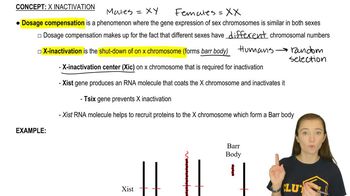Table of contents
- 1. Introduction to Genetics51m
- 2. Mendel's Laws of Inheritance3h 37m
- 3. Extensions to Mendelian Inheritance2h 41m
- 4. Genetic Mapping and Linkage2h 28m
- 5. Genetics of Bacteria and Viruses1h 21m
- 6. Chromosomal Variation1h 48m
- 7. DNA and Chromosome Structure56m
- 8. DNA Replication1h 10m
- 9. Mitosis and Meiosis1h 34m
- 10. Transcription1h 0m
- 11. Translation58m
- 12. Gene Regulation in Prokaryotes1h 19m
- 13. Gene Regulation in Eukaryotes44m
- 14. Genetic Control of Development44m
- 15. Genomes and Genomics1h 50m
- 16. Transposable Elements47m
- 17. Mutation, Repair, and Recombination1h 6m
- 18. Molecular Genetic Tools19m
- 19. Cancer Genetics29m
- 20. Quantitative Genetics1h 26m
- 21. Population Genetics50m
- 22. Evolutionary Genetics29m
2. Mendel's Laws of Inheritance
Sex-Linked Genes
Problem 12f
Textbook Question
Textbook QuestionA woman's father has ornithine transcarbamylase deficiency (OTD), an X-linked recessive disorder producing mental deterioration if not properly treated. The woman's mother is homozygous for the wild-type allele.
If the woman has a son with a man who does not have OTD, what is the chance the son will have OTD?
 Verified Solution
Verified SolutionThis video solution was recommended by our tutors as helpful for the problem above
Video duration:
3mPlay a video:
Was this helpful?
Key Concepts
Here are the essential concepts you must grasp in order to answer the question correctly.
X-Linked Recessive Inheritance
X-linked recessive disorders are caused by mutations on the X chromosome. Males, having one X and one Y chromosome, are more likely to express these disorders if they inherit the affected X. Females, with two X chromosomes, can be carriers if they have one affected X and one normal X, but typically only express the disorder if both X chromosomes are affected.
Recommended video:
Guided course

X-Inactivation
Genotype of the Parents
In this scenario, the woman is a carrier for ornithine transcarbamylase deficiency (OTD) because her father has the disorder and her mother is homozygous for the wild-type allele. This means the woman has one affected X chromosome (from her father) and one normal X chromosome (from her mother). The man does not have OTD, indicating he has a normal Y chromosome and a normal X chromosome.
Recommended video:
Guided course

Gamete Genotypes
Punnett Square Analysis
A Punnett square is a tool used to predict the genetic outcomes of a cross between two individuals. In this case, it can be used to determine the probability of the son inheriting OTD. By analyzing the possible combinations of the mother's X chromosomes (one affected and one normal) with the father's normal X chromosome, we can calculate the likelihood of the son inheriting the disorder.
Recommended video:
Guided course

Chi Square Analysis

 7:56m
7:56mWatch next
Master Sex-Linked Genes with a bite sized video explanation from Kylia Goodner
Start learningRelated Videos
Related Practice



